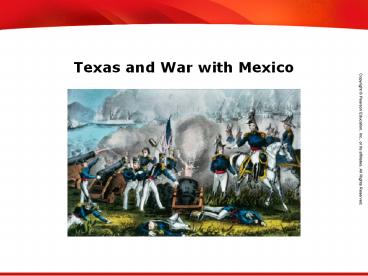Texas and War with Mexico - PowerPoint PPT Presentation
1 / 16
Title:
Texas and War with Mexico
Description:
Explain how Texas won independence from Mexico. Analyze the goals of President Polk. Trace the causes and outcome of the Mexican-American War. – PowerPoint PPT presentation
Number of Views:378
Avg rating:3.0/5.0
Title: Texas and War with Mexico
1
Texas and War with Mexico
2
Objectives
- Explain how Texas won independence from Mexico.
- Analyze the goals of President Polk.
- Trace the causes and outcome of the
Mexican-American War.
3
Terms and People
- Stephen Austin leader of American emigrants who
settled in Austin, Texas - Antonio López de Santa Anna charismatic general
who seized power of Mexico in 1834 - autonomy independent control over ones affairs
- Lone Star Republic new nation created by Texans
in 1835 - Alamo Texas garrison where Santa Anna executed
all the defenders following battle in 1836
4
Terms and People (continued)
- Sam Houston Texas army commander, President,
territorial governor, and later senator - James K. Polk Southern Democrat and
expansionist elected President in 1844 - Zachary Taylor general who led troops at the
borderland between Mexico and the U.S. in 1846 - Winfield Scott general who invaded Mexico
winning at Vera Cruz in 1847
5
How did the revolution in Texas lead to war with
Mexico?
American expansionists sought new territory in
the South and West, making conflict with Mexico
seem inevitable. The flashpoint for conflict
became Texas. The resulting war vastly increased
the size of the United States.
6
American expansionists had their eyes on Texas.
Only 4,000 Hispanic Tejanos lived there in 1821.
Mexico sought to defend and to develop Texas by
inviting settlers. They offered inexpensive land
on three conditions. Settlers had to
- Accept Mexican citizenship
- Worship in the Catholic Church
- Follow the Mexican Constitution, which did not
permit slavery
7
American settlers arrived, but tensions grew as
Americans ignored the Mexican government.
- Led by Stephen F. Austin, 30,000 Anglo-Texans
outnumbered the Tejanos six-to-one by 1835. - Many brought slaves and ignored the Church.
- In 1834, Antonio López de Santa Anna seized power
in Mexico City, seeking greater centralized
control. But Texans wanted more autonomy.
8
- In 1835, Texans declared independence for the
Lone Star Republic. - Santa Anna personally led a siege of Texan forces
at the Alamo in San Antonio. - After twelve days, he stormed the mission and
executed any surviving defenders, including Jim
Bowie and Davy Crockett.
9
Several weeks later, Santa Anna took Goliad and
again executed prisoners, in an attempt to
frighten Texas into surrender.
Instead, Santa Anna created a set of martyrs.
Remember the Alamo, became the Texans rallying
cry. Many Southerners were inspired to volunteer
and joined the Texans.
10
Sam Houston led a counterattack. At the Battle of
San Jacinto, Santa Anna was defeated and taken
prisoner. Houston later became president of the
Lone Star Republic. After statehood in 1845,
Houston served as governor and then as U.S.
Senator from Texas.
11
Fearing execution, Santa Anna signed a treaty
expanding the Texas border to the Rio Grande and
giving half of New Mexico to the Texans.
- Texas became an independent republic.
- The Mexican government refused to honor the
treaty and demanded a return to the original
border at the Nuecos River. - Fighting would persist for ten years over the
disputed borderlands.
12
In 1844, expansionist James K. Polk was elected
president on a promise to obtain both Oregon and
Texas. In Congress, northern Democrats
reluctantly agreed to annex Texas if all of
Oregon was also added.
Britain did not concede all of the territory.
Rather then fight, Polk made a deal to split
Oregon and extend the 49th parallel border with
Canada to the Pacific Ocean. Northerners felt
betrayed.
13
- President Polk claimed all land as far as the
Rio Grande, tripling the previous size of Texas. - General Zachary Taylor was sent to occupy these
border lands. - Mexico objected to the granting of statehood to
Texas and saw statehood as an invasion of Mexican
territory.
The United States annexed Texas in 1845, leading
to war with Mexico.
14
When Mexican patrols killed American soldiers,
Congress declared war on Mexico.
- Southern Democrats favored war, while Northern
Whigs felt that Polk deliberately provoked
Mexico. - The war was popular in the United States.
- Whigs dropped their opposition, fearing they
would be labeled disloyal as the Federalists were
for opposing the War of 1812.
15
The United States easily defeated Mexico.
The U.S. advantages included greater wealth and a
better-equipped military. General Winfield Scott
led an overwhelming campaign from Veracruz to
Chapultepec, forcing Santa Anna to abandon Mexico
City and the war.
After capturing the port of Veracruz, U.S. forces
marched 200 miles to attack Mexico City.
16
The army and navy combined to defeat Mexico.































